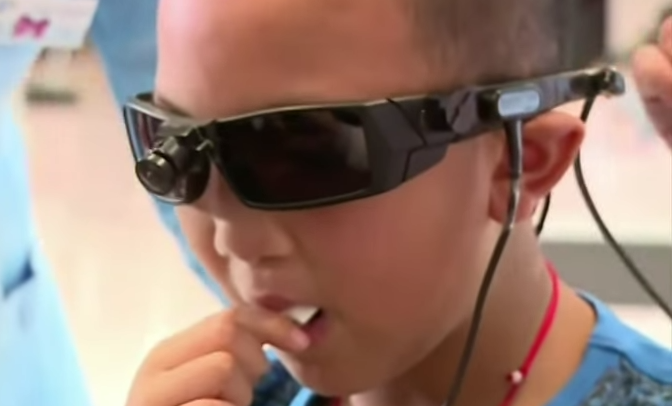FDA Approve BrainPort, Device Which Allows Blind To 'See' With Tongue: Re-Teaching The Brain To Overcome Disabilities [VIDEO]

There are those who learn to use sound to compensate for their blindness as well as those who are deaf, but “hear” music by feeling its vibrations. Now, the BrainPort V100 takes these concepts to new heights by teaching the tongue to see. The recently FDA-approved device is only one of many new medical innovations attempting to take advantage of our brain’s plasticity — its ability to adapt and relearn new skills — as a way to overcome disabilities.
At first glance, the BrainPort V100 looks like nothing more than a square, battery-powered plastic lollipop connected to a pair of sunglasses. According to Medical News Today, there is a tiny video camera mounted inside the sunglasses that captures images. These images are then converted to electrical impulses that are sent to electrodes in the lollipop. When the lollipop is put on the tongue, these impulses can be felt as vibrations, which are then interpreted to give the user a better awareness of their surroundings.
While it may sound complex at first, Wicab Inc., the company responsible for the technology, claims that after some training and a bit of practice, users will be able to interpret the vibrations on their tongue as a way to distinguish the size, shape, and position of objects nearby. Studies showed 69 percent of BrainPort users who completed a year’s training succeeded in object recognition tests, MNT reported. The developers hope the BrainPort will be used alongside either a cane or guide dog to allow the blind to navigate their environment even more efficiently.
How It Works
Whenever we learn a new dance move or how to solve a math problem, the brain develops new neural pathways to reflect this skill and make it easier to repeat. This physical change in the brain’s composition is known as brain plasticity, and it's what allows a person to use the BrainPort effectively. When a person loses a sense, either from birth or injury, their brain develops new neural pathways to compensate for the disability, which is where the BrainPort's functions fit in.
Although it’s the eyes that take in the visual stimulus from our environment, it’s essentially the brain that converts this stimulus into vision. The BrainPort simply re-teaches the brain to see by training it to receive a visual stimulus from the tongue rather than the eyes.
“Medical device innovations like this have the potential to help millions of people. It is important we continue advancing device technology to help blind Americans live better, more independent lives," said Dr. William Maisel, the FDA’s deputy director for science and chief scientist in the agency’s Center for Devices and Radiological Health, according to MNT.
The Power Of The Brain
Brain plasticity is an exciting field of science that is not limited to “seeing” with your tongue. An array of scientific innovations, known as sensory substitution technology, focus on restoring lost senses in never-before-seen ways. The vOICe (Oh, I See!) enables those who are congenitally blind to see by translating visual images into bursts of music, which users then learn to decode. A Kickstarter headed by Dr. David Eagleman, suggests sounds can be converted into electrical signals to restore hearing to those whose hearing is impaired. The device, known as the VEST, is a wearable vest connected to a smartphone, which would theoretically teach users to “feel” sound.
Teaching the brain how to reuse lost connections is also fundamental to innovations in prosthetics. When a person loses a limb, the brain activity used to control the limb remains. Innovative prosthesis devices, such as those made by Ossur, rejoin these connections with an artificial limb. Similar to the BrainPort, the result is a prosthesis that, with time, allows users to control it as easily as they did their natural body parts.
The BrainPort has been available for sale in Europe since 2013 buts its recent FDA approval means that Americans will now be able to test out the fascinating device, too (for a hefty price: according to Bloomberg Business, the device costs around $10,000).



























